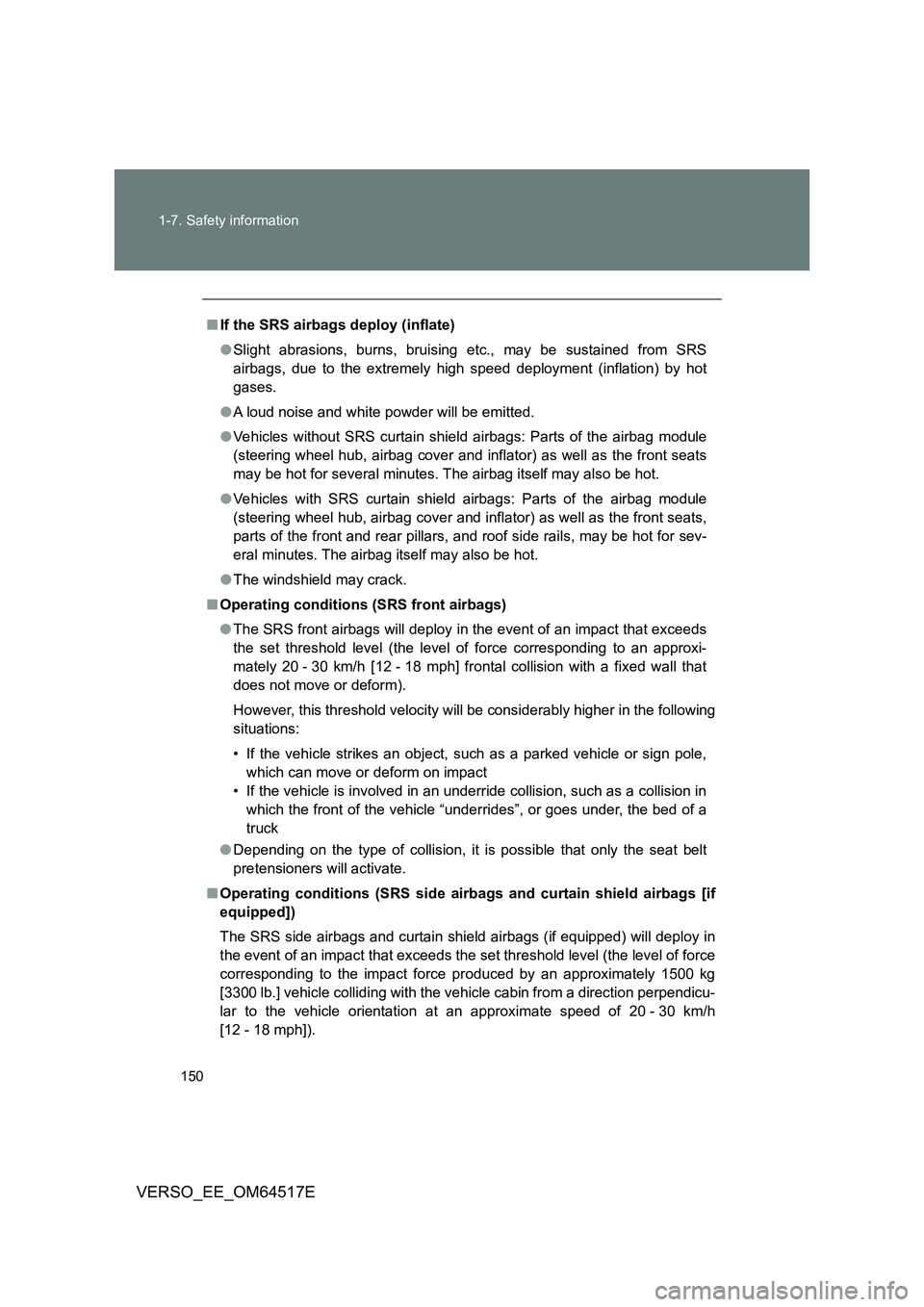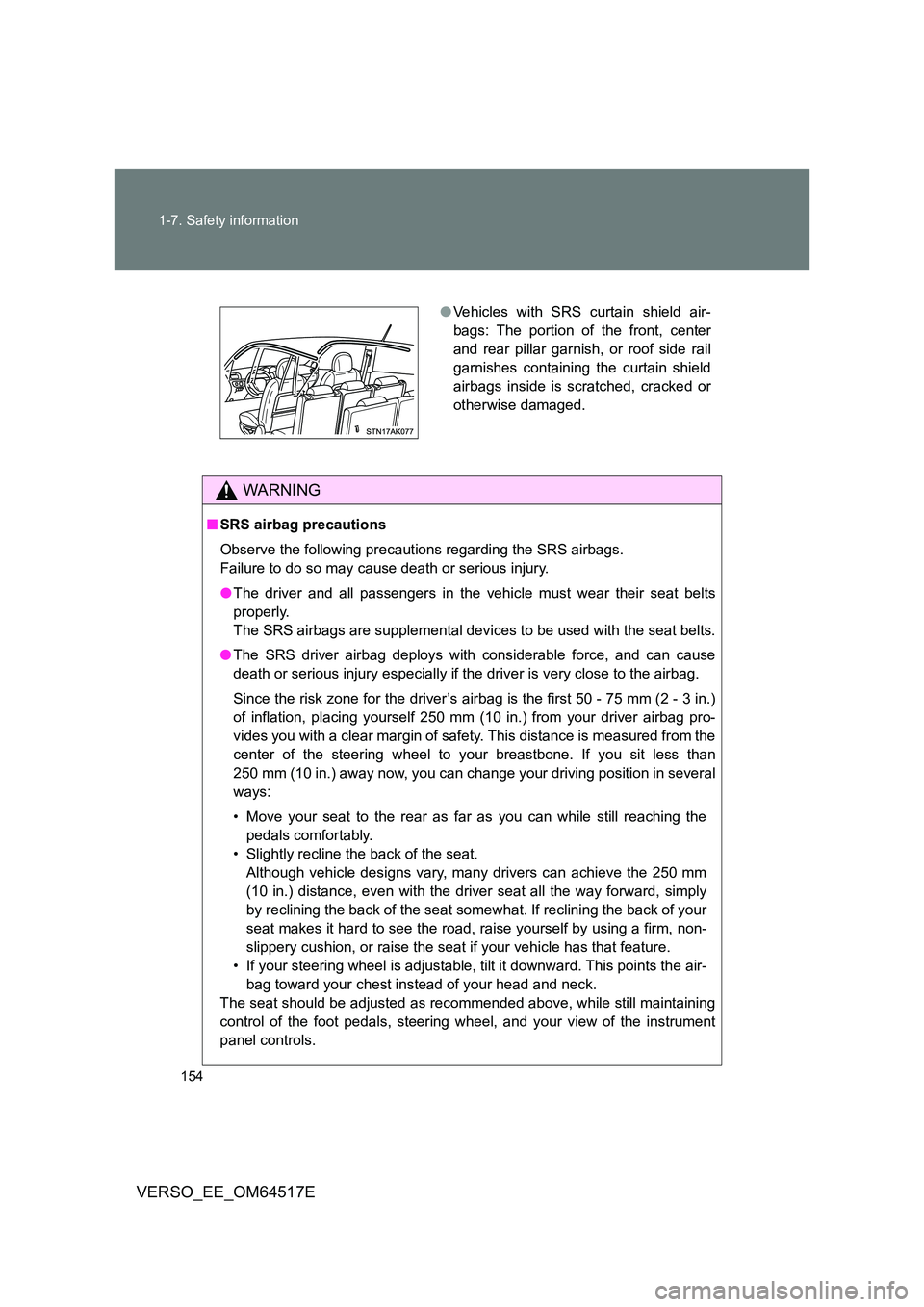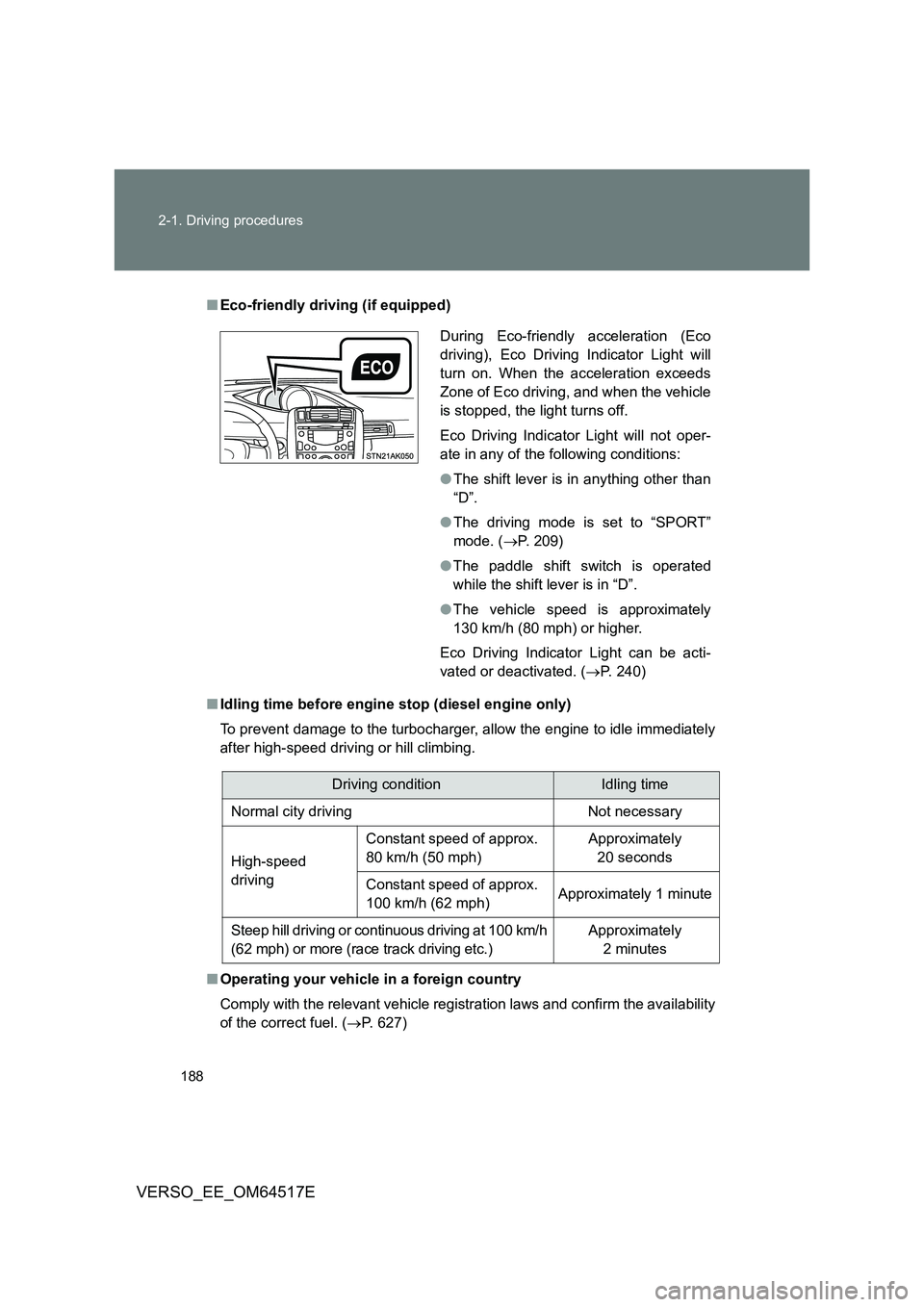Page 150 of 668

150
1-7. Safety information
VERSO_EE_OM64517E
■ If the SRS airbags deploy (inflate)
● Slight abrasions, burns, bruising etc., may be sustained from SRS
airbags, due to the extremely high speed deployment (inflation) by hot
gases.
● A loud noise and white powder will be emitted.
● Vehicles without SRS curtain shield airbags: Parts of the airbag module
(steering wheel hub, airbag cover and inflator) as well as the front seats
may be hot for several minutes. The airbag itself may also be hot.
● Vehicles with SRS curtain shield airbags: Parts of the airbag module
(steering wheel hub, airbag cover and inflator) as well as the front seats,
parts of the front and rear pillars, and roof side rails, may be hot for sev-
eral minutes. The airbag itself may also be hot.
● The windshield may crack.
■ Operating conditions (SRS front airbags)
● The SRS front airbags will deploy in the event of an impact that exceeds
the set threshold level (the level of force corresponding to an approxi-
mately 20 - 30 km/h [12 - 18 mph] frontal collision with a fixed wall that
does not move or deform).
However, this threshold velocity will be considerably higher in the following
situations:
• If the vehicle strikes an object, such as a parked vehicle or sign pole,
which can move or deform on impact
• If the vehicle is involved in an underride collision, such as a collision in
which the front of the vehicle “underrides”, or goes under, the bed of a
truck
● Depending on the type of collision, it is possible that only the seat belt
pretensioners will activate.
■ Operating conditions (SRS side airbags and curtain shield airbags [if
equipped])
The SRS side airbags and curtain shield airbags (if equipped) will deploy in
the event of an impact that exceeds the set threshold level (the level of force
corresponding to the impact force produced by an approximately 1500 kg
[3300 lb.] vehicle colliding with the vehicle cabin from a direction perpendicu-
lar to the vehicle orientation at an approximate speed of 20 - 30 km/h
[12 - 18 mph]).
Page 154 of 668

154
1-7. Safety information
VERSO_EE_OM64517E
WARNING
■ SRS airbag precautions
Observe the following precautions regarding the SRS airbags.
Failure to do so may cause death or serious injury.
● The driver and all passengers in the vehicle must wear their seat belts
properly.
The SRS airbags are supplemental devic es to be used with the seat belts.
● The SRS driver airbag deploys with considerable force, and can cause
death or serious injury especially if the driver is very close to the airbag.
Since the risk zone for the driver’s airbag is the first 50 - 75 mm (2 - 3 in.)
of inflation, placing yourself 250 mm ( 10 in.) from your driver airbag pro-
vides you with a clear margin of safety. This distance is measured from the
center of the steering wheel to your breastbone. If you sit less than
250 mm (10 in.) away now, you can change your driving position in several
ways:
• Move your seat to the rear as far as you can while still reaching the
pedals comfortably.
• Slightly recline the back of the seat.
Although vehicle designs vary, many drivers can achieve the 250 mm
(10 in.) distance, even with the driv er seat all the way forward, simply
by reclining the back of the seat somewhat. If reclining the back of your
seat makes it hard to see the road, raise yourself by using a firm, non-
slippery cushion, or raise the seat if your vehicle has that feature.
• If your steering wheel is adjustable, tilt it downward. This points the air-
bag toward your chest instead of your head and neck.
The seat should be adjusted as recommended above, while still maintaining
control of the foot pedals, steering wheel, and your view of the instrument
panel controls.
● Vehicles with SRS curtain shield air-
bags: The portion of the front, center
and rear pillar garnish, or roof side rail
garnishes containing the curtain shield
airbags inside is scratched, cracked or
otherwise damaged.
Page 179 of 668
179
1
1-7. Safety information
Before driving
VERSO_EE_OM64517E
Airbag manual on-off system
This system deactivates the front passenger airbag.
Only deactivate the airbags when using a child restraint system on
the front passenger seat.
Vehicles with manual air conditioning system
“PASSENGER AIRBAG”
indicator
Vehicles without smart entry &
start system: This indicator
light turns on when the airbag
system is on (only when the
engine switch is in the “ON”
position).
Vehicles with smart entry &
start system: This indicator
light turns on when the airbag
system is on (only when the
“ENGINE START STOP”
switch is in IGNITION ON
mode).
Airbag manual on-off switch
Page 180 of 668
180
1-7. Safety information
VERSO_EE_OM64517E
Vehicles with automatic air conditioning system
“PASSENGER AIRBAG”
indicator
Vehicles without smart entry &
start system: This indicator
light turns on when the airbag
system is on (only when the
engine switch is in the “ON”
position).
Vehicles with smart entry &
start system: This indicator
light turns on when the airbag
system is on (only when the
“ENGINE START STOP”
switch is in IGNITION ON
mode).
Airbag manual on-off switch
Page 181 of 668
181
1-7. Safety information
1
Before driving
VERSO_EE_OM64517E
Deactivating the front passenger airbag
Vehicles without smart entry &
start system: Insert the key into
the cylinder and turn to the
“OFF” position.
The “OFF” indicator light turns on
(only when the engine switch is in
the “ON” position).
Vehicles with smart entry & start
system: Insert the mechanical
key into the cylinder and rotate to
the “OFF” position.
The “OFF” indicator light turns on
(only when the “ENGINE START
STOP” switch is in IGNITION ON
mode).
■ “PASSENGER AIRBAG” indicator information
If any of the following problems occurs, it is possible that there is a malfunc-
tion in the system. Have the vehicle inspected by any authorized Toyota
dealer or repairer, or another duly qualified and equipped professional.
● Neither “ON” nor “OFF” comes on.
● The indicator does not change when the airbag manual on-off switch is
switched to the “ON” or “OFF” position.
Page 183 of 668

2When driving
183
VERSO_EE_OM64517E
2-1. Driving procedures
Driving the vehicle ............ 184
Engine (ignition) switch
(vehicles without smart
entry & start system)....... 198
Engine (ignition) switch
(vehicles with smart
entry & start system)....... 202
Multidrive .......................... 208
Manual transmission......... 214
Turn signal lever ............... 218
Parking brake ................... 219
Horn .................................. 221
2-2. Instrument cluster
Gauges and meters .......... 222
Indicators and warning
lights ............................... 227
Multi-information display ... 232
Fuel consumption
information ...................... 244
2-3. Operating the lights and
wipers
Headlight switch ............... 248
Fog light switch ................. 254
Windshield wipers and
washer ............................ 255
Rear window wiper and
washer ............................ 260
2-4. Toyota Safety Sense
Toyota Safety Sense ........ 261
PCS (Pre-Collision
System) .......................... 268
LDA (Lane Departure
Alert) ............................... 283
Automatic High Beam ....... 288
2-5. Using other driving systems
Cruise control.................... 294
Speed limiter ..................... 298
Toyota parking
assist-sensor .................. 301
Stop & Start system .......... 309
Driving assist systems ...... 316
2-6. Driving information
Cargo and luggage ........... 322
Winter driving tips ............. 325
Trailer towing .................... 329
Page 186 of 668

186
2-1. Driving procedures
VERSO_EE_OM64517E
Starting on a steep uphill
Multidrive
Firmly set the parking brake and shift the shift lever to “D” or
“M”.
Gently depress the accelerator pedal.
Release the parking brake.
Manual transmission
With the parking brake set and the clutch pedal fully
depressed, shift the shift lever to “1”.
Lightly depress the accelerator pedal at the same time as
gradually releasing the clutch pedal.
Release the parking brake.
■ Hill-start assist control
The hill-start assist control allows you to smoothly start off the vehicle on a
steep or slippery uphill incline. ( P. 316)
■ Driving in the rain
● Drive carefully when it is raining, because visibility will be reduced, the
windows may become fogged-up, and the road will be slippery.
● Drive carefully when it starts to rain, because the road surface will be
especially slippery.
● Refrain from high speeds when driving on an expressway in the rain,
because there may be a layer of water between the tires and the road
surface, preventing the steering and brakes from operating properly.
Page 188 of 668

188
2-1. Driving procedures
VERSO_EE_OM64517E
■ Eco-friendly driving (if equipped)
■ Idling time before engine stop (diesel engine only)
To prevent damage to the turbocharger, allow the engine to idle immediately
after high-speed driving or hill climbing.
■ Operating your vehicle in a foreign country
Comply with the relevant vehicle registration laws and confirm the availability
of the correct fuel. ( P. 627)
During Eco-friendly acceleration (Eco
driving), Eco Driving Indicator Light will
turn on. When the acceleration exceeds
Zone of Eco driving, and when the vehicle
is stopped, the light turns off.
Eco Driving Indicator Light will not oper-
ate in any of the following conditions:
● The shift lever is in anything other than
“D”.
● The driving mode is set to “SPORT”
mode. ( P. 209)
● The paddle shift switch is operated
while the shift lever is in “D”.
● The vehicle speed is approximately
130 km/h (80 mph) or higher.
Eco Driving Indicator Light can be acti-
vated or deactivated. ( P. 240)
Driving conditionIdling time
Normal city driving Not necessary
High-speed
driving
Constant speed of approx.
80 km/h (50 mph)
Approximately
20 seconds
Constant speed of approx.
100 km/h (62 mph) Approximately 1 minute
Steep hill driving or continuous driving at 100 km/h
(62 mph) or more (race track driving etc.)
Approximately
2 minutes